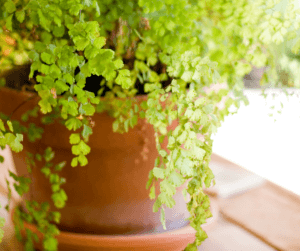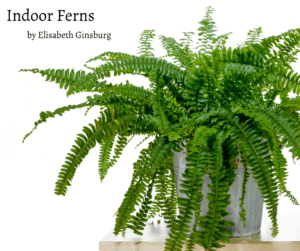
Many of us mix old and new elements in our home décor, which is part of the reason why indoor ferns are so popular. The first fern fossils hearken back to the Devonian period, roughly 400 million years ago. Some of their descendants are twenty-first century indoor fixtures, loved for their beauty, ease of care and the tranquility they impart to the home environment.
The five ferns below adapt well to indoor culture. Some are epiphytes that grow naturally in the debris that accumulates in the crooks of trees. These tree-dwellers get much of their moisture and nutrients from the air around them. They, like other ferns also grow nicely in a potting medium, like Afford Natural and Organic Potting Mix. Appearance and size vary widely, but members of the fern clan are united by the fact that the plants do not reproduce by seed. Instead new ferns are generated from spores that are located on the undersides of the fronds, hiding—almost—in plain sight.
With a few exceptions, indoor ferns like bright, indirect light and a high humidity environment. Position a humidifier nearby or mist regularly. Placing the pots in trays or saucers of pebbles and water also helps. Bathrooms can be a perfect environment, especially in dry winter months. For non-epiphytes, keep the soil moist but not wet, and feed regularly with half-strength liquid fertilizer.
Gardeners in cold winter climates can give their potted ferns summer vacations outside when night temperatures are above fifty-five degrees. If you decide to do so, make sure to place the plants in a shaded location, lest the fronds burn from too much sunlight. Make sure to return them to the house when night temperatures start to dip.
Boston Fern: Old-fashioned, but ever new, the joyous-sounding tropical Nephrolepsis exaltata ‘Bostoniensis’ or Boston fern, is lush, with broad fronds of alternating leaflets. The connection to Boston happened when an attractive variant of the species Nephrolepsis exaltata showed up in a shipment of ferns headed from Philadelphia to Boston in 1874. The variant caught on, leading eventually to the popular modern fern. Since the six-inch wide fronds can grow long—up to three or four feet–with an arching habit, Boston ferns are especially well suited to hanging baskets or being positioned on tall plant stands or pillars. The fronds cascade over the sides of the containers in a way that makes you understand the “exaltata” part of their Latin name.
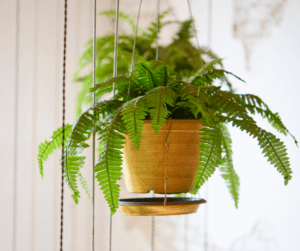
Ribbon Fern: True to its name, Ribbon Fern (Pteris cretica) features a silvery stripe down the center of each narrow leaflet. Growing up to two feet-tall, it works well in containers, with fronds arching out over the sides. A relatively slow grower, Ribbon Fern, sometimes also known as “Cretan Break Fern”, can tolerate a bit more light than some other members of the fern clan, but don’t be fooled into positioning the pot in a south-facing window.
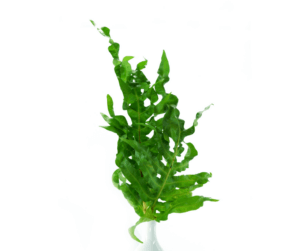
Bird’s Nest Fern: Another good candidate for bathrooms—especially large bathrooms—is Asplenium nidas or Bird’s Nest Fern. An epiphytic plant that gets its “bird’s nest” nickname either from the fact that it grows in the trees in its tropical homeland, or because the fronds rise from a nest-like central rosette. You can grow your bird’s nest indoors in loose, rich soil, but it really needs moisture laden air to look and feel its best. The fronds are long and spatulate—much less delicate-looking than those of some other ferns–and container-grown plants can rise two or three feet with a two-foot spread and an erect growth habit. For those living in warm winter climates and raising the plants outdoors and in-ground, the fronds can reach five feet.
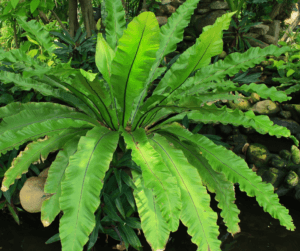
Staghorn Fern: If you have been to a botanical garden’s conservatory, you may have noticed a staghorn fern (Platycerium bifurcatum) mounted on a wall like a hunting trophy. Whether the staghorns are growing in trees in their native habitat, or secured to wall plaques with fishing line, they are held in place by roots protected by rounded, sterile, basal fronds that age from green to brown. The epiphytic plants also sprout fertile fronds, which are the antler-like structures that give rise to the common name. If you don’t have a place for a wall plaque, or don’t like the “hunting trophy” look, staghorns can also be grown in containers in loose, loamy soil. Long-lived (often surviving for decades), the “antlers” can grow up to three feet. Wall-mounted specimens should be taken down regularly for watering.
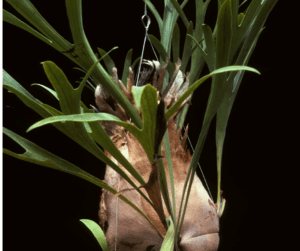
Maidenhair Fern: For something a little more delicate and more traditionally ferny, try Maidenhair Fern (Addiantum raddiatum) The slow-growing fronds feature rounded leaflets that might remind you a little of flat-leaf parsley. Maidenhair is a compact variety, growing one to two feet tall and wide, with a spreading, slightly drooping habit.
